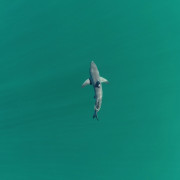- Science News
- Environment
- Waters off French coast in winter may be a deadly trap for small, foraging turtles
Waters off French coast in winter may be a deadly trap for small, foraging turtles
By Tania Fitzgeorge-Balfour, Science writer

A tracked loggerhead turtle on the beach with satellite tracker attached to its shell. Image: Oceane Cottier Aquarium La Rochelle SAS
Turtle habitat boundaries should be updated to include European waters, suggests a new study tracking stranded turtles rescued from the French coast. Their movements after release back into the Bay of Biscay appear related to their size, with larger individuals swimming westwards towards their birth home in the US or Africa, and smaller individuals potentially trapped in the region for winter. These findings will inform strategies to ensure stranded turtles survive after their release.
The documented habitat boundaries of the loggerhead, Kemp’s ridley and green turtles are questioned by a new study suggesting that stranded turtles rescued from European French Atlantic and Channel waters could be visiting the area to forage for food. Published in Frontiers in Marine Science, satellite tracking data reveals that while some turtles may be able to return home, after their rehabilitation and release to Florida in the US, or Cape Verde off the African coast, younger individuals are at risk of being trapped in the region.
“Stranded turtles that were tracked swimming westwards presumably towards their birth homes, after their rescue and release from the Atlantic coast of France, were older and more developed than those that remained in the Bay of Biscay region,” said Dr Philippine Chambault, first author of this study, based at the Aquarium La Rochelle, France. “Turtles that remained in the area were much smaller, possibly trapped in the winter, as they are not able to regulate their body temperature and get lethargic with decreasing sea temperatures.”
“These findings have important turtle conservation implications,” added Florence Dell'Amico, co-author of the study, who oversees the Center of Studies, and cares for the sea turtles at the Aquarium La Rochelle. “Maps of their ecological range need to be updated, and these study findings can help to plan effective rehabilitation and release strategies for turtles rescued from this area.”
► Read original article► Download original article (pdf)
Rescue and rehabilitation
The Aquarium La Rochelle has rescued and rehabilitated more than 200 turtles from the east Atlantic coast of France in the past 40 years. To ensure the turtles they were caring for had the best chance of survival after their reintroduction back into the wild, the center wanted to understand where they traveled to after their release.
“Were the turtles returning to their natal beaches or staying within the Bay of Biscay region? To find out, we glued miniaturized satellite transmitters to the shells of some rescued turtles, which would track their movements over several months,” said Dell'Amico.
“In addition, we used the Copernicus Marine Service to obtain information on the currents, water temperatures and prey abundance along turtles’ trajectories. This enabled us to link turtle movement patterns to these oceanic factors, as well as the size and mass of the turtles,” explained Dr Philippe Gaspar, co-author of the study based at Mercator Ocean, France.
Too cold for small turtles?
“The Bay of Biscay waters are especially cold during wintertime, less than 10°C, and so this area is assumed to be outside the geographical range for turtles. Our observations suggest that while the turtles could be visiting this area to forage for food, it may be an ecological trap for very small turtles that may suffer from hypothermia in the cold months. A turtle’s body temperature is largely controlled by the temperature of the environment, and temperatures below 10oC are often lethal,” said Gaspar.
The team hope to satellite track more turtles in the region to confirm the surprising movement patterns they observed in this study.
“Future work should also focus on genetic analysis and computerized simulations of turtle movement across oceans to compare their routes back to their birth home to their natal origin. Simulations of juvenile turtle dispersal from the beaches that they were born should also be conducted to assess the proportion of individuals that reach western Europe,” concluded Chambault.
REPUBLISHING GUIDELINES: Open access and sharing research is part of Frontiers’ mission. Unless otherwise noted, you can republish articles posted in the Frontiers news blog — as long as you include a link back to the original research. Selling the articles is not allowed.







